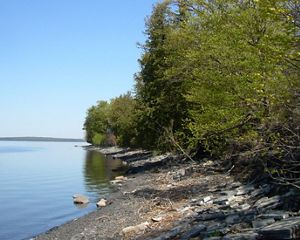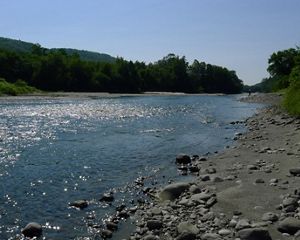The best access to the natural area is via canoe from Lake Champlain. The canoe trip on the lake to and from the creek can be difficult, especially if there are boat wakes on the lake or if the wind is up, but once you're in the creek, it gets easier.
The East Creek Natural Area is located near the state's 398-acre East Creek Wildlife Management Area. It's also adjacent to the Mount Independence State Historic Site. Please read our Preserve Visitation Guidelines.
What to See: Plants
The narrow-leaved cattail marsh at the mouth of the creek provides crucial feeding and nesting habitat for many marsh birds. Arrowhead (also known as duck potato because ducks and muskrats eat its starchy tubers), pickerelweed, and wild rice are also common aquatic plants in the marsh. You can see the purple spiky flowers of the pickerelweed blooming in mass profusion along the creek much of the summer. Other common aquatic or semi-aquatic plants found here include: burreed, pondweed, duckweed, bladderwort, yellow pond lily, coontail, water plantain and scented white water lily.
What to See: Animals
Many water birds nest and feed along the creek, especially in the marsh area: American bittern, the common moorhen, Virginia rail, least bittern, marsh wren and swamp sparrow have been sighted here. Predatory birds like osprey, marsh hawks, and bald eagles, though rare, occasionally soar above the creek in search of a meal. Other common birds seen here include the tree swallow, mourning dove, kestrel, common crow, gray catbird, American goldfinch, killdeer, white-breasted nuthatch, eastern kingbird and cedar waxwing.
Muskrats build houses out of the narrow-leaved cattails along the upper portions of the creek and mink cruise the banks for food. Other mammals like coyotes, bobcats, white tailed deer and shrews inhabit the uplands.
Painted turtles often sun themselves on shore. Their cousins, the snapping turtles, probe the depths of the creek and prey on unsuspecting ducklings. The northern water snake thrives in the south fork of the creek.
Fish are abundant in East Creek, and it is a favorite local fishing hole. When water levels are high in the spring, longnose gar spawn in the creek. Many fish species live here, including the blackchin shiner, bridle shiner, golden shiner, bullhead, rock bass, chub and yellow perch.



